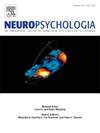刺激左侧下顶叶后,运动图像的转换(而非生成)会受到干扰
IF 2
3区 心理学
Q3 BEHAVIORAL SCIENCES
引用次数: 0
摘要
运动想象(MI)涉及运动图像的生成、保持和转换;然而,人们对每个阶段的神经基础还不甚了解。在此,我们研究了左侧下顶叶(IPL)在运动意象各阶段中的作用。健康参与者(N = 20)在两天内参与了一项多元智能任务(对屏幕上出现的手做出判断;手的横向性判断任务)。过去的文献表明,在这项任务中,手的心理旋转涉及内隐多元智能(即在没有明确指令的情况下,多元智能自发发生)。在任务进行过程中,在刺激开始后 250、500 或 750 毫秒的 50%试验中,对左侧 IPL(根据过去的神经影像学工作确定的位置)施加主动(A 天;120% 静息运动阈值)或假(B 天;安慰剂)神经导航经颅磁刺激(TMS),以对应不同阶段的 MI。参与者的 A/B 天数是随机的。对反应时间和准确性进行的线性混合效应(LME)建模显示,在试验开始后 750 毫秒进行 TMS 刺激时,反应时间更长,主动刺激与假刺激相比反应时间更长。这种效应在手掌刺激与背视刺激、左手刺激与右手刺激时更加明显。主动刺激与假刺激相比,准确率总体下降,而手掌刺激与背视刺激相比,准确率下降幅度更大。研究结果表明,左侧 IPL 参与了图像转换。总之,这项研究工作有助于了解多元智能各阶段的神经基础。本文章由计算机程序翻译,如有差异,请以英文原文为准。
Transformation but not generation of motor images is disrupted following stimulation over the left inferior parietal lobe
Motor imagery (MI) involves the generation, maintenance, and transformation of motor images; yet, the neural underpinnings of each stage are not well understood. Here, we investigated the role of the left inferior parietal lobe (IPL) in the stages of MI. Healthy participants (N = 20) engaged in a MI task (making judgments about hands presented on a screen; hand laterality judgment task) over two days. Past literature demonstrates the mental rotation of hands in this task involves implicit MI (i.e., where MI occurs spontaneously in the absence of explicit instructions). During the task, active (Day A; 120% resting motor threshold) or sham (Day B; placebo) neuronavigated transcranial magnetic stimulation (TMS) was applied to the left IPL (location determined from past neuroimaging work) on 50% of trials at 250, 500, or 750ms post-stimulus onset, corresponding to different stages of MI. A/B days were randomized across participants. Linear mixed effects (LME) modelling conducted on reaction time and accuracy revealed that longer reaction times were observed when TMS was delivered at 750ms after trial onset, and more greatly for active vs. sham stimulation. This effect was exacerbated for palm-vs. back-view stimuli and for left vs. right hands. Accuracy overall was decreased for active vs. sham stimulation, and to a greater extent for palm-vs. back-view stimuli. Findings suggest that the left IPL is involved in image transformation. Overall this work informs on the neural underpinnings of the stages of MI.
求助全文
通过发布文献求助,成功后即可免费获取论文全文。
去求助
来源期刊

Neuropsychologia
医学-行为科学
CiteScore
5.10
自引率
3.80%
发文量
228
审稿时长
4 months
期刊介绍:
Neuropsychologia is an international interdisciplinary journal devoted to experimental and theoretical contributions that advance understanding of human cognition and behavior from a neuroscience perspective. The journal will consider for publication studies that link brain function with cognitive processes, including attention and awareness, action and motor control, executive functions and cognitive control, memory, language, and emotion and social cognition.
 求助内容:
求助内容: 应助结果提醒方式:
应助结果提醒方式:


